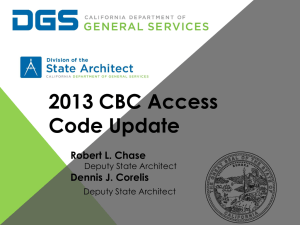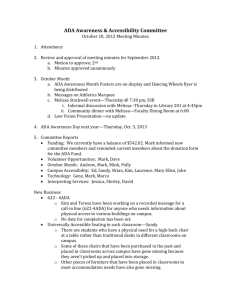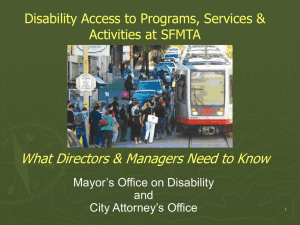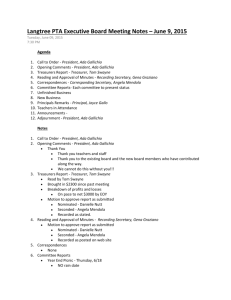ADA path of travel improvements, 20% Disproportionate costs
advertisement
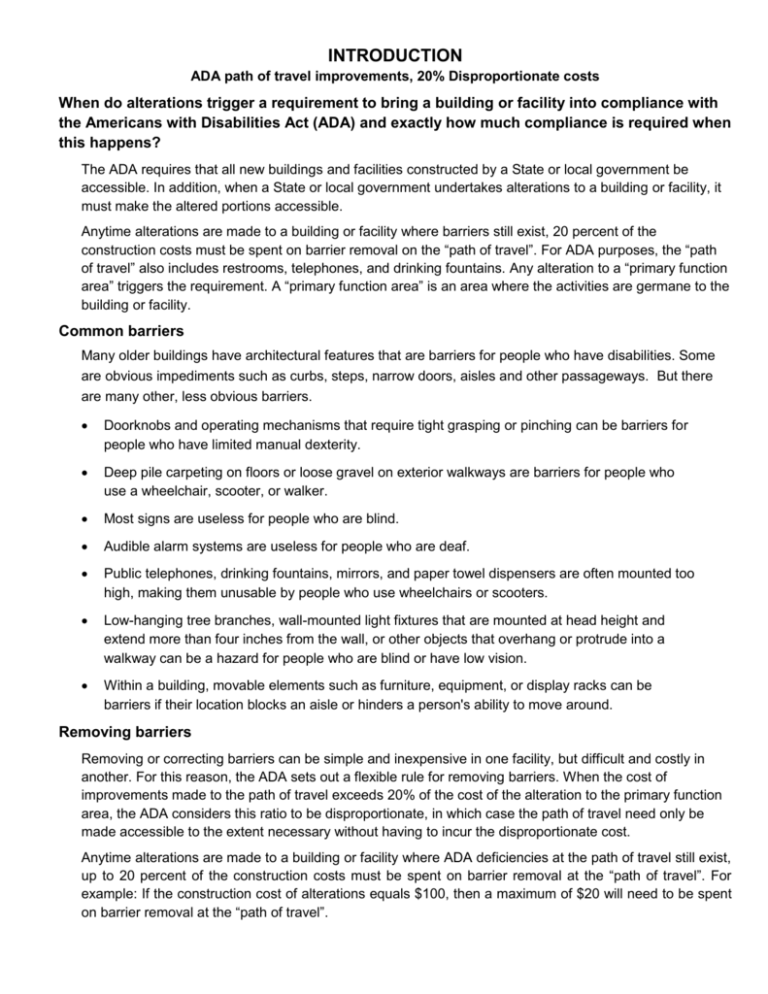
INTRODUCTION
ADA path of travel improvements, 20% Disproportionate costs
When do alterations trigger a requirement to bring a building or facility into compliance with
the Americans with Disabilities Act (ADA) and exactly how much compliance is required when
this happens?
The ADA requires that all new buildings and facilities constructed by a State or local government be
accessible. In addition, when a State or local government undertakes alterations to a building or facility, it
must make the altered portions accessible.
Anytime alterations are made to a building or facility where barriers still exist, 20 percent of the
construction costs must be spent on barrier removal on the “path of travel”. For ADA purposes, the “path
of travel” also includes restrooms, telephones, and drinking fountains. Any alteration to a “primary function
area” triggers the requirement. A “primary function area” is an area where the activities are germane to the
building or facility.
Common barriers
Many older buildings have architectural features that are barriers for people who have disabilities. Some
are obvious impediments such as curbs, steps, narrow doors, aisles and other passageways. But there
are many other, less obvious barriers.
Doorknobs and operating mechanisms that require tight grasping or pinching can be barriers for
people who have limited manual dexterity.
Deep pile carpeting on floors or loose gravel on exterior walkways are barriers for people who
use a wheelchair, scooter, or walker.
Most signs are useless for people who are blind.
Audible alarm systems are useless for people who are deaf.
Public telephones, drinking fountains, mirrors, and paper towel dispensers are often mounted too
high, making them unusable by people who use wheelchairs or scooters.
Low-hanging tree branches, wall-mounted light fixtures that are mounted at head height and
extend more than four inches from the wall, or other objects that overhang or protrude into a
walkway can be a hazard for people who are blind or have low vision.
Within a building, movable elements such as furniture, equipment, or display racks can be
barriers if their location blocks an aisle or hinders a person's ability to move around.
Removing barriers
Removing or correcting barriers can be simple and inexpensive in one facility, but difficult and costly in
another. For this reason, the ADA sets out a flexible rule for removing barriers. When the cost of
improvements made to the path of travel exceeds 20% of the cost of the alteration to the primary function
area, the ADA considers this ratio to be disproportionate, in which case the path of travel need only be
made accessible to the extent necessary without having to incur the disproportionate cost.
Anytime alterations are made to a building or facility where ADA deficiencies at the path of travel still exist,
up to 20 percent of the construction costs must be spent on barrier removal at the “path of travel”. For
example: If the construction cost of alterations equals $100, then a maximum of $20 will need to be spent
on barrier removal at the “path of travel”.
Although not an all inclusive list, here are some of the general rules of thumb to remember:
A common misconception about the ADA is that older buildings are not covered or do not have to comply,
they are "grandfathered." These types of misconceptions are simply not true.
The “path of travel” requirement provides that when a “primary function” area of an existing facility is
altered, the “path of travel” to that area must also be made accessible, but only to the extent that the cost
of doing so does not exceed twenty percent (20%) of the cost of the “alterations” to the “primary function”
area. For the purposes of this part, the term “path of travel” also includes the restrooms, telephones, and
drinking fountains serving the altered area.
As per the applicable ADA provisions, it would be unacceptable to alter any “primary function” area without
improving the “path of travel”, unless the “path of travel” already complies with ADA. For instance, if a
tenant space includes a “primary function” area, then the “path of travel” must be improved if noncompliant, despite the consequences for any lessees’ or ownership.
Entities can alter as many elements within a “primary function” room or space as they like without
triggering a requirement to make the entire room or space accessible based on the alteration of individual
elements. However, if the intent was to alter the entire space, the entire space must be made accessible
and comply with the applicable requirements of Chapter 2 of the 2010 Standards.
Newly constructed or altered items that may have an effect on accessibility, must be made accessible at
the time of installation if altered or replaced. The changed portion(s) must be made accessible as if newly
constructed.
Non-complying existing construction and alterations must be corrected, and are not considered a portion
of the funds required for the 20% disproportionate costs at the ADA path of travel improvements. Existing
construction and alterations are considered non compliant, if they did not comply with the applicable codes
or standards required at the time of installation.
The International Building Code (IBC) mandates that a design must ensure compliance with federal
accessibility requirements. Many local codes such as the IBC contain accessibility provisions, but they are
separate from the ADA Standards. It is very common for architects and contractors to follow only their
local building codes, which may not provide the same degree of accessibility to persons with disabilities.
Compliance with local building codes does not ensure compliance with the ADA. In the few places where
requirements between the two differ, the requirements of ADA prevail, unless the adopted code or
standard is more restrictive. Simply put, it is best to follow the requirements that will result in greater
accessibility.
You can find the specifics in the Department of Justice’s ADA Standards
State and local government facilities must follow the requirements of the 2010 Standards, including both
the Title II regulations at 28 CFR 35.151; and the 2004 ADAAG at 36 CFR part 1191, appendices B and D.
In the few places where requirements between the two differ, the requirements of 28 CFR 35.151 prevail.
It is also important to note that the federal standard (ADA) will supersede a state or local code unless the
code provides for greater or equal protection of individuals with disabilities.
Page 2 of 8
5-10-2012
NAU WORKSHEET ADA path of travel improvements, 20% Disproportionate costs
NAU WORKSHEET
ADA path of travel improvements, 20% Disproportionate costs
NAU Project Number:________________________________________________________________
Project Name:______________________________________________________________________
Name, Title of person completing this
worksheet:_________________________________________________________________________
#1 Net Construction Cost of “Alteration” to the
“Primary Function” areas (1*)
#2 Required 20% cost (2*)
$_________________________________________
$______________________________________
Overall Costs – Exempt Costs = Net Costs
Net Costs – 80% = 20% Disproportionate Costs
28 CFR 35.151(b)(4)(iv) (B), (1) thru (6): In choosing which accessible elements to provide, priority
should be given to those elements that will provide the greatest access, in the following order (3*)
#4 Costs associated with providing An
accessible entrance; (4*)
+$
#5 Costs associated with providing An
accessible route to the altered area; (5*)
+$
#6 Costs associated with providing At least
one accessible restroom for each sex or a
single unisex restroom; (6*)
+$
#7 Costs associated with providing Accessible
telephones; (7*)
+$
#8 Costs associated with providing Accessible
drinking fountains; (8*)
+$
#9 Costs associated with providing additional
accessible elements such as parking, storage,
and alarms. (9*)
#10 Total cost of accessible element upgrades
to the “path of travel” (10*)
+$
=$
Page 3 of 8
5-10-2012
NAU WORKSHEET ADA path of travel improvements, 20% Disproportionate costs
(1*) Foot Notes:
Provide the total dollar amount for the Net Construction Cost of “alterations” to the “primary function”
area. { Please read below, and use the “Footnote (1*) Worksheet” below.}
What is considered a “Primary function”? A “primary function” is a major activity for which the facility is
intended or where the activities are germane (relevant, pertinent, relatable) to the establishment or
program activity. Examples of areas that contain a “primary function” include, but are not limited to, the
dining area of a cafeteria, those rooms or any area where educational sessions are held, kitchens or other
preparation areas that may be used by the general public or within a private dormitory room, the meeting
rooms in a conference center, as well as offices and other work areas in which the activities of the public
entity using the facility are carried out (e.g. employee offices & employee work areas where nonemployees or the general public must be able to approach, enter, and exit.)
There can be multiple areas containing a “primary function” in a single building. Primary function areas
are not limited to public use areas only. They can be any area where people carry out one or more of the
major activities for which a facility is used. For instance in housing at a place of education, the private use
or exclusive use of any room for Fraternity/Sorority meetings, as well as the private sleeping rooms with
their own bathrooms or kitchens, are all considered primary function areas.
What is considered an “alteration” and what items are considered exempt “alterations”? The ADA
uses the term “alteration” to mean any change to an existing building or facility that affects usability. As per
DOJ & ADAAG written documents, “alterations” include, but are not limited to
remodeling, renovating, rehabilitating, reconstructing, resurfacing of circulation paths or vehicular
ways, historic restoration, changing or rearranging structural parts or elements,
and changes or rearrangement in the plan configuration of walls and full-height partitions,
or making other changes that affect or could affect the usability of the building or facility or portion
thereof. (FYI: Definition of Facility. “All or any portion of buildings, structures, site improvements,
elements and pedestrian or vehicular ways located on a site.” Definition of Element. “An
architectural or mechanical component of a building, facility, space, or site.”)
Examples of “alterations” may include such as but not limited to the following: Restriping a
parking lot, adding walls, moving walls, moving a fixed ATM to another location, installing a new
sales/reception counter or display shelves, changing a doorway entrance to a new location, replacing
furniture/fixtures, flooring or carpeting.
Example of exempt alterations: Normal maintenance, such as reroofing, painting, or
wallpapering, asbestos removal, or changes to mechanical and electrical systems may not be
alterations, installation or alteration of fire protection systems. Unless they affect the usability of the
building or facility. In determining disproportionate cost, see Footnote (1*) Worksheet below.
Page 4 of 8
5-10-2012
NAU WORKSHEET ADA path of travel improvements, 20% Disproportionate costs
Footnote (1*) Worksheet
1a Overall Construction Costs to the “Primary Function”
areas: ◦◦◦◦◦◦◦◦◦►
In determining
disproportionate
cost, the following
materials in items
2a, 3a & 4a may
be deducted from
the overall cost of
the project.
(These items are
permissible ,only
if allowable under
the established
criteria, and as
enforced by the
Department of
Justice).
2a. Deduct “Alterations to windows,
hardware, controls, electrical outlets,
and signage shall not be deemed to
be alterations that affect the usability
of or access to an area containing a
primary function.” ◦◦◦◦◦◦◦◦◦►
3a.Deduct “Normal maintenance,
reroofing, painting or wallpapering,
asbestos removal, or changes to
mechanical and electrical systems
are not alterations unless they affect
the usability of the building or
facility.” ◦◦◦◦◦◦◦◦◦►
4a. Deduct installation or alteration
of fire protection systems (IBC)
◦◦◦◦◦◦◦◦►
“Net Construction Costs Of Alteration to the Primary
Function areas”
Deduct the total cost of exempt alterations in 2a 3a 4a from
the Overall construction costs of the “Primary Function”
areas in 1a. This will equal the “Net Construction Costs Of
Alteration to the Primary Function areas”. ◦◦◦◦◦◦◦◦◦◦◦►
$
-$
-$
-$
=$
Transfer this net amount to #1 on the other worksheet.
Page 5 of 8
5-10-2012
NAU WORKSHEET ADA path of travel improvements, 20% Disproportionate costs
(2*) Foot Notes:
Provide the dollar amount that is equal to 20% of the total dollar amount for “Net Construction cost of
Alterations to the Primary Function areas”. { 20% of #1 is the minimum $ amount required and should
be spent on deficiencies at the path of travel }
The ADA does have limits for barrier removal. Disproportionate costs (“path of travel”
improvements): Removing or correcting barriers can be simple and inexpensive in one facility, but
difficult and costly in another. For this reason, the ADA sets out a flexible rule for removing barriers. When
the cost of improvements made to the path of travel exceeds 20% of the cost of the alteration to the
primary function area, the ADA considers this ratio to be disproportionate, in which case the path of travel
need only be made accessible to the extent necessary without having to incur the disproportionate cost.
Anytime alterations (for an explanation of “alterations”, see footnote 1*) are made to a building or facility
where ADA deficiencies at the path of travel still exist, up to 20 percent of the construction costs must be
spent on barrier removal at the “path of travel”. For example: If the construction cost of alterations equals
$100, then a maximum of $20 will need to be spent on barrier removal at the “path of travel”.
(3*) Foot Notes:
FYI: Items #4 thru #9 of the worksheet are mandatory improvement costs associated with upgrading the path
of travel to current ADA standards, and are only appropriate if there are deficiencies in the path of travel
serving the primary function areas.
After providing an initial site visit, it is important to ask yourself “what are the priorities for barrier removal
along the path of travel to the primary function area, that will provide the greatest access?” Understanding
how customers arrive at, enter and move through your building to get to each primary function area and/or
area of alteration will go a long way in identifying existing barriers and setting priorities for their removal.
Do people arrive on foot, by car, or by public transportation? Does your particular building provide
parking? How do customers enter and move about within your building? In any event “priority should be
given to those elements that will provide the greatest access”. In developing an implementation plan for
readily achievable barrier removal, the Design Professional, NAU Project Manager, and any other NAU
facilities stakeholders should consult with the appropriate NAU organizations representing persons with
disabilities (such as NAU Office of Affirmative Action & Equal Opportunity, NAU Disability Resources, NAU
Commission on Disability Access and Design’s) to solicit their suggestions. These organizations may
provide useful guidance in identifying the most significant barriers to remove.
For example, the ADA regulations recommend the following priorities for barrier removal:
Providing access to your entrance from public sidewalks, parking areas, and public transportation.
o
Entrance doors
o Site arrival points Accessible routes within the site shall be provided from public
transportation stops; accessible parking; accessible passenger loading zones; and public
streets or sidewalks to the accessible building entrance served. [1104.1]
Providing access to the primary function areas within your building; Accessible routes shall coincide with
or be located in the same area as a general circulation path. Where the circulation path is interior, the
accessible route shall also be interior.
Providing access to public restrooms;
Removing barriers to other amenities offered to the public, such as drinking fountains.
Page 6 of 8
5-10-2012
NAU WORKSHEET ADA path of travel improvements, 20% Disproportionate costs
(4*) Foot Notes:
(B) Costs that may be counted as expenditures required to provide an accessible path of travel may
include
(1) Accessible Entrances: This includes the building entrance(s) and may also include how
customers arrive at the building and facility. In any event, priority should be given to those
elements that will provide the greatest access.
For example: One small step at an entrance to the building or along the walking route from site
arrival points (public transportation stops; accessible parking; accessible passenger loading
zones; and public streets or sidewalks) to the accessible building entrance(s) can make it
impossible for individuals using wheelchairs, walkers, canes, or other mobility devices to simply
approach and enter the interior of a building. Removing barriers may be accomplished in a
number of ways, such as installing a ramp or a lift or re-grading the walkway to provide an
accessible route. If the main entrance cannot be made accessible, an alternate accessible
entrance can be used. If you have several entrances and only one is accessible, a sign should
be posted at the inaccessible entrances directing individuals to the accessible entrance. This
entrance must be open whenever other public entrances are open.
(5*) Foot Notes:
(B) Costs that may be counted as expenditures required to provide an accessible path of travel may
include:
(1) An accessible route to the altered area. Costs associated with providing an accessible route
to the altered area, for example, the cost of widening doorways or installing ramps, etc.
(6*) Foot Notes:
(B) Costs that may be counted as expenditures required to provide an accessible path of travel may
include:
(2) Costs associated with making restrooms accessible, such as installing grab bars, enlarging
toilet stalls, insulating pipes, or installing accessible faucet controls. In any event, priority should be
given to those elements that will provide the greatest access.
(7*) Foot Notes:
(B) Costs that may be counted as expenditures required to provide an accessible path of travel may
include:
(3) Costs associated with providing accessible telephones, such as relocating the telephone to an
accessible height, installing amplification devices, or installing a text telephone (TTY). In any event,
priority should be given to those elements that will provide the greatest access.
Page 7 of 8
5-10-2012
NAU WORKSHEET ADA path of travel improvements, 20% Disproportionate costs
(8*) Foot Notes:
(B) Costs that may be counted as expenditures required to provide an accessible path of travel may
include:
(4) Costs associated with relocating an inaccessible drinking fountain. In any event, priority should
be given to those elements that will provide the greatest access.
(9*) Foot Notes:
(B) Costs that may be counted as expenditures required to provide an accessible path of travel may
include:
Additional accessible elements such as parking, storage, and alarms.
(10*) Foot Notes:
Add up all costs in #4 thru #9 , then write down this total dollar amount in #10.
Page 8 of 8
5-10-2012
NAU WORKSHEET ADA path of travel improvements, 20% Disproportionate costs



